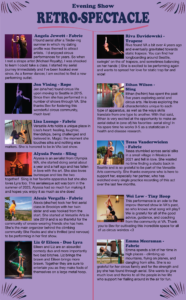
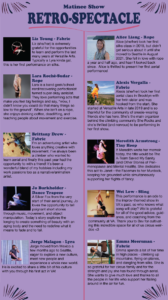
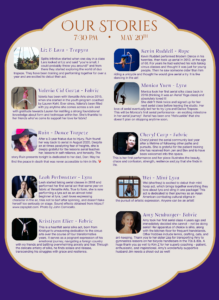
Our Stories Evening Programs – 1
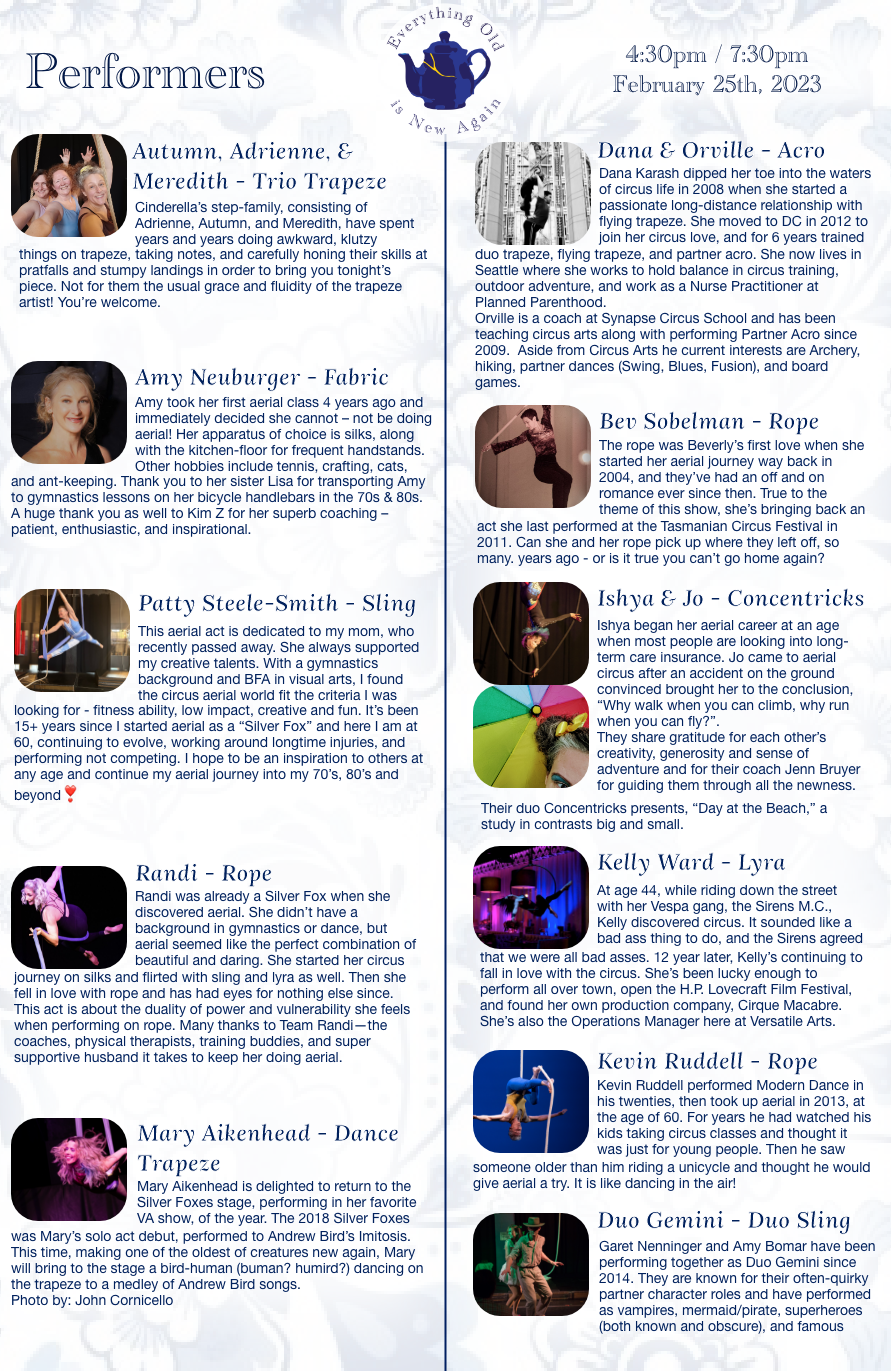

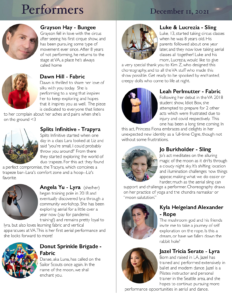
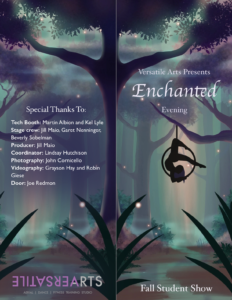
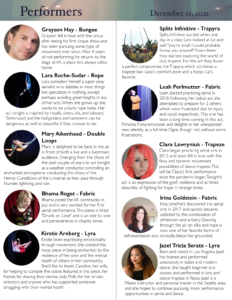
I recently had an experience as a student that, while stressful and fairly traumatic, was useful in that it reminded me of what our aerial beginners go through when learning scary new tricks, and reinforced my belief in structured progressions. It’s often tempting to skip the first steps in learning something new — whether you’re a confident, capable student, or an instructor with a confident, capable student — but here’s a great example of why you should avoid that temptation.
My partner and I have been taking a lead-climbing class at a local climbing gym. The final class of the series was all about falling and catching falls, which I know is a necessary part of lead climbing but nonetheless, I had some serious trepidations about the whole situation (true confession: I am afraid of heights). I thought I made it pretty clear that I was a little freaked out, but in retrospect, I should have been more explicit about that.
The class started with a lecture about the types of catches (hard vs soft) and how you do them and when you would do them, and then we were instructed as to what we were supposed to do as climber or as belayer (catcher). There was no demo. The instructor asked my partner and me to go first and sent the other pair off to practice other skills. I did the falling part first, which entailed climbing up about 20′, clipping into the carabiners set up along the way, and then when you reach the designated spot…you just fall. Jump off a perfectly good wall. And then climb up a little higher and do it again. A few more times. I went first, with Shawn (my partner) catching me.
That part went reasonably well, but some of the falls were pretty big and I was feeling a lot of adrenaline when I came down. But instead of getting a break to recover, we immediately swapped roles and they had me catch Shawn. Now, he outweighs me by about 40%. In the lecture, they said 30% was the rule of thumb, after which you consider adding a sandbag or something to add weight to the belayer. But they didn’t want me to use one yet. So basically, right out of the gate, never having caught a fall before on this type of belay device, I tried to catch my much-larger partner. This involved essentially just letting the force pull me into the wall while attempting to pull hard on the tail of the rope. It did not go well. And my nervous system got more agitated, which meant all the feedback they were trying to give me just made me confused and stressed. We tried a few more times, with little progress that I could discern, after which I said I was done. I was either going to punch someone or start crying or both.
So. How could this have gone better for me?
First off, a demo of the skills would have been super helpful. I didn’t even know I needed it until afterwards, but it would have gone a long way to complement the lecture. Not everyone is a visual learner, but I am and should have asked to see what I was about to do. Or I should have asked the other pair to go first so I could observe.
Second and more importantly, having me start with the most difficult version of the skill was a recipe for failure. My guess is that the instructor saw that I was competent and strong and just figured that I could skip the easier steps (even, say, just catching someone smaller than I am). This is the trap we need to avoid, as both students and teachers. Even the most capable students can be challenged by new skills, have stress reactions, or be freaked out by something that might seem easy. This is why we teach the angel drop with the “training bra” extra wrap the first few times, and why we drill students on how to unwrap the figure-8 wrap so many times before they do their first salto. The adrenaline of even simple drops can cause the best students to get confused or overloaded.
Lastly, having me go straight from falling to catching gave my nervous system no time to recover from one stressful thing before going to another. Learning new skills – especially dynamic, scary ones – involves not just your muscles but your brain and your whole nervous system. This is why we don’t necessarily go through the whole progression in one lesson, or why we walk away from a new skill after the first few tries to give the body and mind some time to integrate and recover.
I have since had some very constructive discussions with the instructor about how they could create a progression to use in this scenario, and he’s been really receptive and grateful for the feedback. He’s a good teacher who made a bad call in this situation.
So please, all of you: if you’re a teacher, follow the progressions, and be attentive to your students’ stress levels and fears. And students, don’t hesitate to tell your instructor if you’re nervous about something, or feeling stressed about a skill. Ask for a simpler version if you feel like you’re skipping past your comfort zone. And if you’re asked to do something that seems overly easy to you, humor your instructor; remember that we’re trying to keep you safe while teaching your body to defy gravity.
It is not lost on me that our annual “Manuary” show fell on the weekend of the biggest march for women’s rights in the history of ever. I’ve been sitting for a bit with how I feel about the fact that we spent the weekend showing off our men-folk., and I’ve come to this conclusion: I feel great about it.
As it turns out, circus – particularly recreational circus – happens to be one realm that is permeated by bad-ass women, both on the equipment and behind the scenes. We express our power every single day when we show up to train and nobody questions whether we are strong enough or brave enough or any sort of enough. I cannot think of a single circus skill about which anyone would say, “oh, that’s just for men.” I know women bases, women straps artists, women doing release moves on rope, you name it. Frankly, there are some moves where being male-bodied is a distinct disadvantage. I’ve even had men come up to me after shows and ask if guys are allowed to do aerial training because everyone they saw on stage was female.
So yeah, I am delighted that we took the time to celebrate the amazing, diverse, fearless men who worked their butts off to put on one of the best shows that has ever graced our stage. And let’s be clear, when I say “men,” I mean that in the most inclusive way possible – gay, straight, bi, trans, non-binary, women in male drag. This was no chest-thumping testosterone-fest – although fun was certainly poked at that stereotype. This was a demonstration not just of strength and power but of humor, naughtiness without vulgarity, vulnerability, flexibility, grace, and pure joy. I’m not ashamed to say that one act – you know who you are – was so full of serenity and soul that it brought me to tears. All of it woven together in a storyline about male strippers auditioning for a new club!
Strippers, you say? Yes, there was a whole lotta clothing removed during this show. I don’t know how many wife-beaters were harmed in the making of Manuary, but it is not a small number. And there were moments when I pondered how we could create a space where female performers could tear off their shirts and perform topless without it feeling distracting or inappropriate. I hope we can get there – although personally, inverting while topless would put me in danger of giving myself a black eye. But meanwhile, I allowed myself to appreciate the beautiful diversity of the human form on our stage while also appreciating the bravery (and pain-tolerance) I imagine it took for many of them to put themselves out there.
So yes, I salute and celebrate the Men of VA, just as I salute and celebrate everyone who marched for women’s rights, for civil rights, for human rights. Community is important at every level, and that is what I saw and felt on our stage. I couldn’t be prouder.
Thanks to the Magic of the Internet, it is easier than ever to learn new skills from instructional videos: how to put on makeup, how to change your oil, how to do a crazy silks drop. Which of these things is not like the others? The one that could leave you paralyzed or dead if you do it wrong. Which is why so many aerial instructors discourage you from learning from videos – it’s just too easy to get something wrong and end up with a serious injury, or at least bad habits from having no feedback from anyone qualified to provide it.
That said, there is no way to stop curious and hungry aerial students from watching videos and trying stuff from them. (It’s like when my partner says, “stop picking at that” — ain’t gonna happen, even though I know he’s right.) Some folks aren’t lucky enough to live near a great studio, or maybe don’t have the funds to spend on regular classes. Heck, I did it when I was starting out and didn’t know any better. So I thought that instead of issuing a blanket “Videos are evil” statement, I’d try to come up with some guidelines to help students look at a video from a safety perspective and make smart decisions about which ones to trust their precious bodies to.
First off, I am only talking about videos that are intentionally provided as instructional material. I am not talking about watching a performance video and trying to figure out a trick from it. If you really really really want to learn something you saw in a video, take it to a qualified instructor and ask them if they can teach it to you. Be prepared for them to say no for any number of valid reasons that I won’t go into here.
Turning our attention to videos that are specifically marketed as providing aerial instruction…here are some questions you should ask to assess the safety of the video. (Spoiler alert: these are also questions you should ask any time you consider training with anyone, whether through a video or in person.)
As I mentioned above, many of these same criteria – and more — apply to choosing a studio/instructor. The better-informed students are, the better able we will be to hold aerial studios – and videos – to a higher standard of safety as the practice continues to become more widespread. The American Circus Educators has developed a safety program that recognizes circus facilities and aerial teacher training programs through a set of guidelines designed to foster best practices. It’s a new program, but more studios are applying all the time (including Versatile Arts!).
Meanwhile…make informed choices and ask good questions when you’re not sure if something is safe or not. The best way for us to make everyone safer is to talk about it!
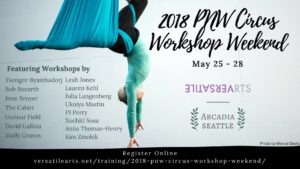 We are delighted to announce our fifth Circus Workshop Event, May 25-28, 2018! Click here for details and registration.
We are delighted to announce our fifth Circus Workshop Event, May 25-28, 2018! Click here for details and registration.
Versatile Arts is hosting our first workshop weekend in May, featuring best-of-the-northwest instructors and a wide variety of aerial and ground disciplines. Read all about it here!
March 6 – April 30
By T Lawrence-Simon
Circus is an amazing blend of physical effort and conceptual art. Whether it’s for fitness, fun, professional, semi-professional goals, circus always requires a fully concentrated effort. With such a full on art/sport, it’s a totally understandable and inevitable feeling to hit a plateau. It might occur in the physical form, and you just feel like your splits aren’t getting any flatter, your pullups aren’t getting any easier, your toe hang isn’t hanging any longer. It could be mental, you just feel like you do the same routine everyday (if you’re performing with a long running show, you might ACTUALLY BE doing the same routine everyday). It could be artistic, you don’t feel the inspiration to move forward, maybe inspiration to create that new act, or just the inspiration to try a new skill.
I wanted to write out some plateau busters, that I’ve done or encountered over the years. Try one out, try them all, see what happens. It’s always good to have a little arsenal of tools in your kit.
Whether you’re doing circus for the cool Facebook statuses, to look damn sexy, to see how far you can go, to get hired by a circus, or all of the above; pushing through those plateaus is part of the journey. Having the perseverance to keep going is part of what makes circus awesome…because if you push through, the reward is fascinating!
A week ago, about two thirds of the way through the act I was performing, I felt a crrrrrunch in my rib cage. I was lifting into a meathook from a bit of a side-to-side sway, a move I had rehearsed dozens of times, but this time, as my hips lifted to bring my legs up and over into a pike around my arm, something in my ribs moved in a way that ribs should very definitely not move. I finished the act – adrenaline is an amazing drug – and went back stage to apply an ice pack and take some ibuprofen. I wasn’t in terrible pain, but when I went to sit down to watch the rest of the show, I felt another shift and a sharp jab and thought….”Crap. I’ve gone and injured myself.”
In the 10 years I’ve been training in the aerial arts, I count this as my third significant injury – by which I mean something that kept me on the sidelines for more than a day or two. Interestingly, the first one was essentially the same as this latest one, except less severe – I pulled some intercostals performing a meathook in a performance. But that was 8 years ago and I was inexperienced and tired and improvising and really had no business doing that move. I’ve treated it with great respect since then, as my students can attest to – and yet it still came back to bite me in the ass. Or the ribs, as the case may be.
(The other injury, since you’re probably wondering, involved landing on my head while working on back circles on trapeze. No concussion, but I had vertigo for about three weeks until a miracle worker in the guise of a physical therapist fixed it for me. If you fall on your head and get vertigo, go see Michele Frances!)
So, how should I feel about this injury? I didn’t fall, wasn’t trying something out of my range, didn’t make any glaring errors – wrapping wrong for a drop, missing a catch, etc – and I was properly warmed up. I didn’t feel like adrenaline got the better of me – I was aware of it and consciously harnessed it earlier in the piece, in fact. Looking at the video, it seems like I simply timed the move a bit wrong. I’ll probably be out of aerial commission for a month or two, but conveniently was just about to take a short sabbatical from my studio anyway. I won’t need surgery, or really any treatment other than rest and careful exercise to keep the blood flow to the area so that the cartilage can heal.
Given all that, I am finding it hard to feel bad about hurting myself. Which leads me to wonder….should we accept injury as a fact of life for professional aerialists? We downplay it to insurers, we do everything to prevent it for our students, and yet….how many aerialists reading this have never had an aerial-related injury of any kind? Many are from overuse or improper technique, and those we strive to avoid as instructors. But sometimes…shit happens.
I wrote a related post back in January (“When in Doubt…Get Down”) and I hate to sound like a broken record. But I think it’s important to remind everyone that even well-trained, well-rehearsed, healthy, strong aerialists get hurt. Then again, you can also break an ankle stepping off a curb wrong, or crack a rib by coughing too hard. At least I got injured doing something I love….and it sure makes for a great story at the chiropractor’s office.
By Adrienne Mays, aerial student and soon-to-be mother“I’m so excited I’m pregnant! Oh, I still have 5 weeks of this session of aerials left. And there’s that class I really want to take next session, plus I just started rehearsing for a new act. Hmmm, what to do?” There’s a lot of information out there on exercising while pregnant, but not really anything specific for aerials. I’ve put together some of the information that seemed the most relevant to me, combined a bit with my experience of being pregnant (so far) and how that’s impacted my workouts. I’ve broken it down into what I view as the salient points. No matter what you decide, always tell your health care provider about your aerials and get their opinion, and for sure let your instructors know immediately, as that will affect your training and their decisions in class for you.
#1. Hormones are making your ligaments and joints crazy, whatever may be happening to your moods.
So my midwife cautioned me right away that my ligaments were going to be getting loose from the relaxin and estrogen, and I thought, “Well, sure, but not really noticeably until towards the end, right?” Turns out, no. There is actually a relaxin peak at 12 weeks in, as well as the build in the 3rd trimester. The increased estrogen and progesterone start loosening everything RIGHT AWAY. The risk of dislocations and strains happens pretty immediately. I really noticed this one day, probably only about 11 weeks in, when I was carrying a couple bags of groceries up to my apartment. In only two flights of stairs I noticed my elbow joints were starting to separate! Eek! I’d already stopped aerials, mostly because of the wanting to vomit every second of the day, but I was grateful not to be suspending myself on a trapeze right about then. Good strength and keeping your muscles engaged when doing any activity or carrying things will help prevent dislocation.
#2. Blood pressure, lung capacity, and passing out.
So now you’re growing another person, and your body is providing for that person. One of the effects is a massive increase in blood volume, also starting immediately. Most women notice a drop in blood pressure, resulting in dizziness when standing or moving too quickly. If you have a dramatic drop in blood pressure, this can lead to fainting with very little provocation. Your health care provider should be able to tell you how your blood pressure is doing, but be aware that if you are getting dizzy standing up, the exertion of aerials may cause you to pass right out, possibly at elevation. Bev would be pissed, so if you’re getting dizzy, faint, or blurry vision, get down and rest.
As the baby grows, there’s also the shoving of your organs out of it’s way. Many of your organs get pushed upwards, compressing your lungs and leading to difficulty breathing and again, the danger of dizziness and passing out. Same rules apply.
#3. The Great Inversion Debate
There is a lot of different viewpoints on inversions while pregnant. My midwife told me no inversions beginning immediately. My acro instructor was also not pleased that I was still in class in the first trimester, and he was actually the first one to tell me why. Inversions are actually most dangerous in your first trimester because your placenta isn’t full formed yet, and the body isn’t really set up to support the weight of bigger uterus +baby+plancenta while upside down. This can lead to placental abruption, ie. Your placenta ripping partly or completely off of or out of your uterus. If it doesn’t lead to a miscarriage right away, it can still cause blood or oxygen supply problems to the baby down the road.
Once in the second and third trimesters, there seems to be some arguments that gentle, supported inversions of short duration (under 1 minute) can actually help with back pain, and preparing the ligaments to stretch for birth. Many yoga traditions support this practice, others say no inversions while pregnant at all. Health care practitioners (that I’ve spoken to on this) seem to be against all inversions, but you should speak to yours and make the decision that feels right to you.
#4. General risks of falling and abdominal compression.
Sure, falling is bad. When you’re pregnant though, it’s REALLY BAD. The first trimester warning for inversions is extra true when adding falling to the equation. Don’t rip your placenta! It’s not only the unplanned fall either, but any drop with an abrupt halt, even planned, can cause problems. After the first trimester we’re less concerned about the placenta and more about abdominal compression and possibly damaging your uterus itself, ripped abdominal muscles that are trying to stretch out, and possible damage to the baby itself. Twists are similarly concerning for that reason, and my acro instructor wouldn’t let me do any twists at all as soon as he knew. In my pregnancy yoga class there are some gentle twists for the upper body that minimize abdominal twisting, but overall, twists are taboo for the pregnant lady. Also, with your balance point shifting, your blood pressure dropping, your ligaments stretching, even the most balanced and strong of us may find that even going down a set of stairs a bit challenging.
#5. Core strength and abdominal stretching.
I couldn’t find much documentation to support this point, all I have is what my midwife told me specifically and some personal stories. Most advice for newly pregnant women is to make sure you get enough exercise and tone up for giving birth. This is not really a concern for an aerialist. We have tone, particularly core strength. After my initial exam, my midwife actually told me that I was no longer allowed to do any core work because I had too much tone. I needed to let those muscles relax a bit so they could stretch to accommodate the baby without tearing. Evidently if you’re in too good of shape your muscles may just rip apart instead of stretching. Ew. That would also lead to a much longer healing time after the birth that you couldn’t get back to exercising for, which I know I don’t want. I also have a friend who is a professional dancer who kept dancing all through pregnancy, and then found that her pelvic muscles were so strong that they wouldn’t stretch enough to let her pelvis open for the baby to get out, and so had to get a C section. Every body is different, and proportions and flexibility vary, but I did want to share that info. Please talk to your health care provider as to what they think is best for you. I’m following my midwife’s advice of only prenatal yoga, swimming and walking until the baby is out.
Always most important is listen to your body, your health care practitioners, and your instructors. Sad as it may be to decide to take a break from aerials, it’s better to take good care of yourself so you can get back to it as soon as possible after the baby is born.
http://www.spinningbabies.com/techniques/241-inversion
http://www.expandinglight.org/free/yoga-teacher/advice/inversions-pregnant.php
http://www.babycenter.com/404_what-activities-should-i-avoid-during-pregnancy_7229.bc
http://www.befitmom.com/balance.html
If you look around the walls in the main studio at Versatile Arts, you see a variety of brightly-colored signs: “Point Your Toes!” “Remember to Breathe!” “Wrap Your Thumbs!” And there in the corner is another one that says in large letters, “When in Doubt….Get Down.” We joke that that can mean that if you don’t know what to work on next, try a little dance break….but what it really means is “err on the side of caution.” If you’re not sure if you’re set up right for that drop….walk it out. If you’re not sure about your grip strength for that next move….come down and rest a while first.
I’m writing about that sign because we had an incident at VA recently in which as far as I can tell, the only thing that anyone could have done differently was to consider that saying. It was in an advanced class, with one of our most experienced aerialists working with a very encouraging and enthusiastic coach. Other people in the class had already done the move. She had walked through it a couple of times and thought she understood it. But when she set up for it, she had some doubts – was she high enough up, did she really understand where she had to grab. And the instructor encouraged her to try it, confident that even if she missed it, the worst that would happen was that she would land on her back. So she went for it – and she missed, fell on her neck, and knew right away that she’d need emergency medical attention. (Which she got, and will be fine – some soft tissue and nerve damage but she’ll recover fully, thank goodness.)
What went wrong here? Of course we ask ourselves that any time someone gets hurt – which I am happy to say is a rare occurrence at Versatile Arts. (In almost 6 years of operation, this is only the second time that we’ve had to send someone to the hospital. The first was a broken wrist from falling off a trapeze.) The equipment did not fail. She was over a crash mat. She had walked through the skill a few times. Should the instructor have stopped her when it seemed like she was unsure? Should she have stopped herself when she started wondering if she was high enough? Should someone else in the room have stepped in? Yes, probably all of those things should have happened. Would I have stopped her if I’d been there? It’s honestly hard to say. When you are working with advanced students, you trust them to know their limits. And when you’re working with enthusiastic instructors and you’ve been doing this a long time, you want to go for it. I can’t say for sure that this situation would have triggered my safety radar.
So what do we learn from this? First off…it’s a valuable reminder to all of us that this aerial stuff is, in fact, dangerous. We do our best to protect our students by having a structured curriculum, by breaking down skills to make sure they learn them thoroughly, and by having firm prerequisites for upper-level classes. We check our equipment regularly and enforce safety rules during classes and open gyms. We maintain low teacher-student ratios so that students can be observed as much as possible during classes. But in the end, we need to remember that there is always the chance of injury from this sport – just as there is with rock climbing and gymnastics and snowboarding and so many of the other fun, exciting things in life. And that one moment of inattention – by teacher or student – can have dire consequences.
But just as importantly, this is a reminder to listen to your gut when you are up there in the air. If something doesn’t feel right, come down. Always know how to walk out of a drop. Nobody will ever give you a hard time for making the decision not to go for it. You might be set up perfectly, but if you’re distracted or unfocused, don’t take the risk.
One last word on this. There are times in class when I will tell a hesitant student to “just go for it.” We’ve all done that. I’ve watched them set up, I know it’s correct, I know they are ready for it, and I am intimately familiar with what can happen even if it doesn’t go perfectly. Sometimes they just need that little bit more encouragement to go for it. But even then, even if I am sure it will be fine, if a student says no, not ready – they come down. No questions asked.
So, all of you…be careful out there. And when in doubt….get down.
My teaching specialty over the 11 or so years I’ve been involved in aerial has become teaching beginners, and I really love it. It takes a special type of skill and patience to teach an absolute beginner once you’ve been doing something for a while, and while I might not have guessed it would appeal to me so much, it does.
One of the many reasons I like teaching newbies is dispelling some of the myths about doing aerial work. They include the following:
I started doing aerial work when I was 21 years old, with no real plan for what I might do with it and having absolutely no movement background. In fact, my adolescence was about the least healthy I’ve come across in those I’ve met and talked with over the years, and at the time I spent 90% of my life sitting in front of a TV or a computer.
In fact, trying aerial significantly improved, if not flat out saved, my life, and I became hooked. I quit smoking and created a healthier relationship with alcohol. I had finally found a form of exercise I could be creative with, after having found other forms of exercise mind numbingly boring, so I continued to get stronger and improve my stamina. And now I could express myself artistically with movement, which was a huge shift in the quality of my life.
I began performing 3 years later, and teaching shortly after that. I’ve performed for over 1000 people at a local festival, been a part of two theatrical troupes as an aerialist as well as performing many interesting and fun gigs as a duo, as well as having been asked to perform across the country. I’ve been teaching others for years, ranging from teaching beginner and level 1 aerialists to working with fellow teachers and high level students on musicality and choreographing their acts.
I have done all this without a gymnastics or dance background, and without full splits in either direction. In fact, due to the way my hip sockets developed, most people’s straddle splits are wider than mine are. And yet I have enjoyed countless and priceless benefits from doing aerial work, I enjoyed a small but successful career as a performer, and now I get to show new people that aerial can do amazing things for them, too.
I mean, what could be better than that?
– Courtnee Papastathis
One of the questions I get asked most often is “How do I increase my grip strength?” which is almost immediately followed by “How do I prevent injury, cramping and fatigue while working on grip strength?” Two questions, one answer: by harnessing the power of the Rice Bucket.
The rice bucket workout is a great supplement to any grip strengthening regime when used to create balanced musculature. Balanced musculature increases overall strength and dramatically decreases discomfort [cramping and fatigue] and the chance of injury.
Sound good? Not sure where to start? The bucket at Versatile Arts (located next to the North rosin bin upstairs) has a list of exercises pasted on the side. Use the resistance of the rice to create strength and balance. When first starting out, repeat an exercise for 30 seconds, or until fatigue sets in – which ever occurs first. Train with the bucket twice a week, or after each regular workout – not to exceed three times per week in the beginning. Once this starts to get easy, increase the duration of exercise to 45 seconds and eventually one minute.
Some of my personal favorites are listed below:
Iron Fist – Stab your fingers deep into the rice and then make a fist. Retract. Repeat. This is my hand. I want it strong.
Screaming Talon – Stab your fingers [together] deep into the rice and then open your hand wide. Retract, palms away from you. Repeat. Your hand is afraid of the rice. The rice should be afraid of your hand.
Fists of Fury – Embed fists deep in rice. Rotate one direction. Don’t worry that you can’t see. Fear is the only darkness. Breathe.
Fists of Fury, Part II – Embed fist deep in rice. Rotate other direction. Seek not to know the answers, but to understand the questions.
Eagle Claw – Stab rice with fingers together and claw at it. Don’t be tender. An eagle can break a wolf’s back with one strike.
Crush the Pebble – Grab handfuls of rice and attempt to make gruel out of it, quickly and repeatedly. Only the undisciplined spill rice on the floor. Control the rice. It is your destiny.
Want to learn more? Contact me or attend my conditioning classes.
– Jenn Q
At first glance, “Versatile Arts” might seem like a strange choice of name for an aerial studio. Most aerial schools have “circus” or “trapeze” or at least something relating to the air in their name; this one could just as easily be a photography studio or music school. To understand the logic behind the name, you need to know how the company came to be.
Before I was the director of an aerial studio, I was a software engineer. I worked at three different companies over 18 years and got my master’s in computer science from UC Berkeley along the way. Software wasn’t just what I did; it was who I was for my adult life. When I walked away from Microsoft in 2003, it was more than a career change; it was an opportunity to reinvent myself.
Having no idea what I was going to do next, I decided to “try on” a variety of things. I dabbled in glass art, did some art modeling, learned about landscaping by giving my whole front yard a makeover, mastered the art of sourdough bread, and took my first aerial classes. Some of these “stuck” and I decided to create a business that could serve as an umbrella for a variety of pursuits. That business needed a name, and I’ve always liked the word “versatile” and appreciated that trait in myself – plus it sounded much better than “Indecisive Arts”.
Over time, the aerial-related aspects of the business came to the forefront: instruction, performance, costuming, and equipment. In 2012, Versatile Arts is first and foremost an aerial studio and training facility. So how is the name still relevant, you ask?
 At VA, we start all of our beginning students out on a variety of apparatus – trapeze, rope, and tissu – from day one. This cross-training helps them build strength and develop a broad base of skills that will serve them throughout their aerial career. And while we certainly applaud students who want to focus on one discipline, we also encourage them to branch out and try new things sometimes– both to stay fresh and to see how skills on one apparatus can transfer to another. In 2011, we introduced the Versatile Artist program, which recognizes students who have completed acts on multiple apparatus – so if, for example, you see someone wearing a Versatile Artist tank top around the studio, you know that that person has performed original choreography on at least two different apparatus. (In case you’re curious…I am personally up to 7. I believe in leading by example!)
At VA, we start all of our beginning students out on a variety of apparatus – trapeze, rope, and tissu – from day one. This cross-training helps them build strength and develop a broad base of skills that will serve them throughout their aerial career. And while we certainly applaud students who want to focus on one discipline, we also encourage them to branch out and try new things sometimes– both to stay fresh and to see how skills on one apparatus can transfer to another. In 2011, we introduced the Versatile Artist program, which recognizes students who have completed acts on multiple apparatus – so if, for example, you see someone wearing a Versatile Artist tank top around the studio, you know that that person has performed original choreography on at least two different apparatus. (In case you’re curious…I am personally up to 7. I believe in leading by example!)
We are also branching out beyond aerial instruction with the addition of our Ballroom studio. Our curriculum now includes ballet, modern, and tap dance offerings as well as a combination aerial and dance repertory class. Yoga and other fitness classes are coming soon as well. We hope that these expanded offerings will give our aerialists the tools they need to stay healthy and challenged while not sacrificing our commitment to providing the best aerial instruction possible.
Ultimately, Versatile Arts is about encouraging yourself to expand your comfort zone, saying “yes!” to trying new things, and – as we like to say around the studio – “embracing the power of ‘and’.”
Beverly Sobelman
Director, Versatile Arts
The Cathedral houses dozens of classes per week and open gym times every day. But with two other spaces – the Ballroom and the Blue Room – there are always opportunities for rehearsals and private lessons.
Versatile Arts provides the highest quality instruction available. Visit our Instruction tab to learn more about classes and workshops currently offered in our space.
The Ballroom provides a beautiful space for a variety of activities, from dance rehearsals to bar classes. Check our calendar for current offerings or contact us to rent the space!
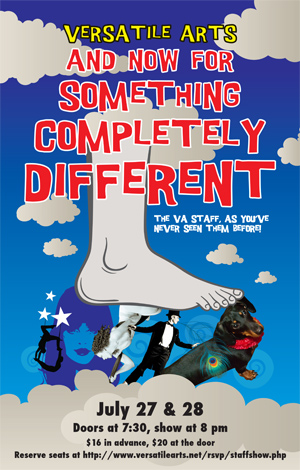 Friday, July 27 and Saturday, July 28. Doors at 7:30, show at 8 pm sharp.
Friday, July 27 and Saturday, July 28. Doors at 7:30, show at 8 pm sharp.
It’s time for the annual Versatile Arts staff show! This time, we challenged our talented aerial instructors to not just come up with new acts, but to perform on a new apparatus or in a new situation on an old apparatus (e.g., doubles instead of solo). You’ll see all-new acts, and in many cases, you’ll see folks performing in ways they’ve never done before!
We’ve also got some very special guest performers, including some of the four-legged variety. You won’t want to miss this!
Cost is $16 in advance by credit card, $20 cash or check at the door. Whether you prefer to pay in advance or at the door, you may reserve your seats here:
https://www.versatilearts.net/rsvp/staffshow.php
In addition to our more casual ‘date night’ shows, Versatile Arts also puts on at least one major student show every year. The spring 2012 show, “Feel the Love,” featured 23 acts performed over 3 shows. These productions give our students a chance to show their friends and family what they spend all those hours working on – and where the scrapes and bruises come from! – as well as raising money to make the studio even better equipped.
Versatile Arts loves giving back to the community, and we love animals, so what better event for us to participate in than the annual Woodland Park Zoo fundraiser? Each year we take a group of 20-25 students and instructors to the zoo to entertain the donors as they arrive for the Jungle Party auction. The 2011 theme was “Animal All-Stars,” which included everything from tree frogs to toucans to gorillas – and a giraffe on stilts!
People often ask whether aerial performance is for men as well as women. The answer is a resounding “YES!”, as proven by our January, 2012 show, “The Men of Versatile Arts”. Also known as the “Manuary” show, this incredibly entertaining evening featured 8 acts by 9 of our talented male students and was so popular that we had to add a second night! And while we had our share of beefcake, there was an equal display of grace, flexibility, and style. Truly a highlight of VA history.
Click here to purchase!